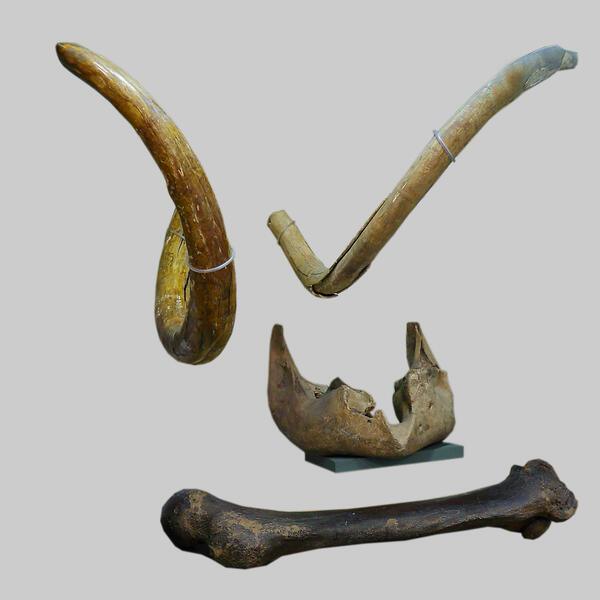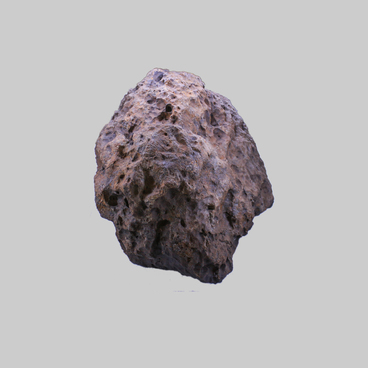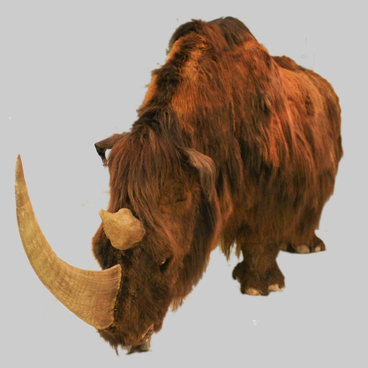The Pleistocene Epoch began about two and a half million years ago. During that epoch, Earth had gone through numerous periods of extreme cold and relative warmth. Back then, the territory of the Southern Urals was covered with mountainous mammoth steppe. It was home to diverse wildlife, with the mammoth as its largest representative.
Modern scientists recognize four to six types of the Mammuthus genus. The main population of the ‘northern elephants’ died out around 10,000 BC, but the last mammoths could be found on the territory of the Wrangel Island as late as 4,000 years ago.
The mammoth’s anatomy was the closest to that of the modern Indian elephant. Its body was covered in a thick coat of coarse hair, which was up to a meter long on the sides. Combined with a dense undercoat and a thick layer of subcutAneous fat, it provided good protection against low temperatures. The color of the coat ranged from brown and black to yellow-brown and reddish.
Mammoths lived in small herds, which consisted of females, young males, and baby mammoths. The herd was led by one of the females. Males kept their distance and lived alone or in small groups of two or three individuals. Like modern elephants, mammoths had a single very large tooth on each side of the jaw. As the teeth abrased, they shifted forward and were replaced by new ones. This could happen up to six times within an animal’s lifetime. During the warm season, the animals mainly ate grass and grains. In winter, their diet contained a lot of young branches and shoots of trees and shrubs. Mammoths needed a large amount of food. For example, the stomach of one of the animals revealed by the thawing permafrost contained 250 kilos of plant mass. Mammoth herds roamed constantly in search of food, preferring to move along the river valleys and tundra-steppe lowlands, where the grass was thicker.
The melting of glaciers and the increase in humidity at the end of the Pleistocene turned large areas of the hard permafrost soils of the mammoth steppe into swamps and marshes that could neither feed large animals nor bear their weight. This was the main reason why mammoths became extinct.
In ancient times, people in Western Europe often mistook mammoth bones for the remains of giants. This gave rise to legends about one-eyed cyclops, since many thought the nasal aperture on the mammoth’s skull was an eye socket.
Modern scientists recognize four to six types of the Mammuthus genus. The main population of the ‘northern elephants’ died out around 10,000 BC, but the last mammoths could be found on the territory of the Wrangel Island as late as 4,000 years ago.
The mammoth’s anatomy was the closest to that of the modern Indian elephant. Its body was covered in a thick coat of coarse hair, which was up to a meter long on the sides. Combined with a dense undercoat and a thick layer of subcutAneous fat, it provided good protection against low temperatures. The color of the coat ranged from brown and black to yellow-brown and reddish.
Mammoths lived in small herds, which consisted of females, young males, and baby mammoths. The herd was led by one of the females. Males kept their distance and lived alone or in small groups of two or three individuals. Like modern elephants, mammoths had a single very large tooth on each side of the jaw. As the teeth abrased, they shifted forward and were replaced by new ones. This could happen up to six times within an animal’s lifetime. During the warm season, the animals mainly ate grass and grains. In winter, their diet contained a lot of young branches and shoots of trees and shrubs. Mammoths needed a large amount of food. For example, the stomach of one of the animals revealed by the thawing permafrost contained 250 kilos of plant mass. Mammoth herds roamed constantly in search of food, preferring to move along the river valleys and tundra-steppe lowlands, where the grass was thicker.
The melting of glaciers and the increase in humidity at the end of the Pleistocene turned large areas of the hard permafrost soils of the mammoth steppe into swamps and marshes that could neither feed large animals nor bear their weight. This was the main reason why mammoths became extinct.
In ancient times, people in Western Europe often mistook mammoth bones for the remains of giants. This gave rise to legends about one-eyed cyclops, since many thought the nasal aperture on the mammoth’s skull was an eye socket.



